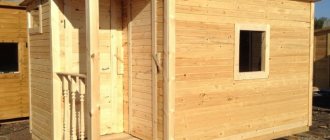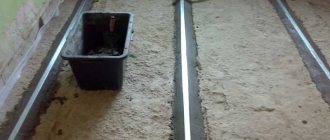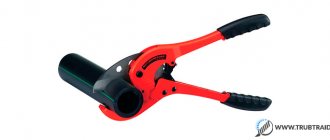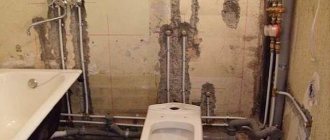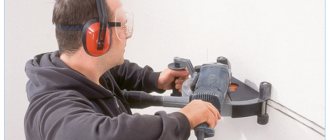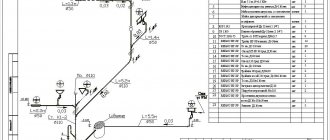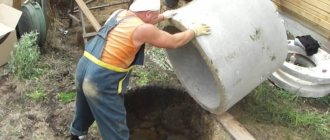In order to make living in a private house as comfortable as possible, it is important to correctly position and install all communications. And home plumbing is no exception. “What kind of pipe is used for underground water supply?” - This is the question asked by everyone who is just starting to run a household and has no experience in laying communications.
Pipes for laying underground are selected depending on the purpose and type of pipeline
Features of HDPE pipes
If you are planning to install a cold water supply system in your local area, I recommend using HDPE pipes. Low-pressure polyethylene pipes have a number of unique properties that are not available to their metal or concrete counterparts.
Advantages and disadvantages
The main quality of HDPE for external systems is ease of installation. Laying and assembling a water pipeline does not require special knowledge. In any hardware store you will find low-density polyethylene pipes of various diameters, sizes and wall thicknesses. In addition, HDPE products have the following features:
- Polyethylene does not react chemically with water transported through the water supply system. That is, the liquid entering the house will not contain impurities.
- HDPE pipes are 7 times lighter than metal products. This makes transportation and installation easier. When laying a water pipeline in a trench, it is not necessary to secure the network with additional supports.
- The smooth inner surface prevents the formation of blockages and growths.
- Products made from HDPE absorb noise; such pipes are convenient for installing sewer systems as risers.
- The cost of the product is lower, installation and transportation are cheaper than metal or concrete pipes.
- HDPE service life is up to 50 years.
Polyethylene pipes can withstand high pressure, temperature changes and are resistant to cracking: if the water in the pipe freezes and increases in volume, this will not affect the integrity of the surface. The disadvantages of HDPE products include low resistance to high ambient temperatures. Therefore, it is advisable to use them for the installation of underground water supply pipelines.
Insulation materials
To insulate a DIY water supply system in a dacha, several options for special materials are used. The first variety, called “pipe shell,” is a pipe-shaped shell.
The second type is a variety of insulating materials, manufactured in rolls of various widths and lengths.
“Pipe shells” are made from polystyrene foam, extruded polystyrene foam and polyurethane foam. It is a product in the form of a semi-rigid cylinder, which consists of two halves. It is put on the pipe and fastened with overlaps, special glue, clamps and foil tape.
Typically the length of such a “shell” is one meter, but can reach two meters. Such products can be produced with additional coatings made of foil, fiberglass or galvanization. This type of insulating material is quickly and easily installed, as well as removed and replaced during repairs. The “shell” covered with fiberglass can be used for all types of water pipes or pipelines that are located in the ground, outdoors and indoors.
It will be useful to read:
Methods for drilling a well for water Water has always been and is one of the necessary elements of life. And even the very first settlements tried to be created on...
Foam plastic is called foamed plastic in the form of small white balls (known to absolutely everyone), which, when making a “shell,” are pressed into the shape of a pipe and then treated with steam. Interestingly, this material is almost 97-98 percent air. The advantages of polystyrene foam are lightness, practicality and low cost. Disadvantages include fragility and fragility.
Extruded polystyrene foam is a type of foam plastic, the production of which uses pressure and high temperature. The result is a material that is stronger than polystyrene foam. I like this material for its resistance to environmental influences (does not rot). It does not absorb moisture, has a long service life, is lightweight and easy to install.
Polyurethane foam is a foamy plastic material consisting of numerous cells filled with gas
It attracts attention with the best noise insulation characteristics, good mechanical strength, ease of use and low weight.
Among the insulating materials that are produced in the form of rolls, it is worth mentioning stone wool, foamed polyethylene and glass wool.
Glass wool is an insulation material consisting of glass fibers
It attracts attention with its noise and heat insulation characteristics, durability and price. The disadvantages include the fact that when working with glass wool, it is necessary to follow safety precautions, since this material is prickly. During isolation work, the respiratory organs and skin are protected with protective equipment (special work suits, gloves and masks)
During isolation work, the respiratory organs and skin are protected with protective equipment (special work suits, gloves and masks).
Stone or basalt wool fibers are made from molten rocks of volcanic origin, slag and silicate materials
This insulating material attracts attention due to its high resistance to various loads and impacts, its non-flammability, and the fact that products of various shapes and densities are made from it.
Foamed polyethylene is obtained by processing ordinary high-density polyethylene using propane and butane. It is an elastic porous material consisting of a large number of cells. Foamed polyethylene stands out among other insulating materials for its highest resistance to water, and it is also unaffected by fungi and bacteria. It tolerates the effects of petroleum products, alkalis and acids well.
Rules for installation work
Before starting the installation of a pressure water pipeline made of polyethylene pipes, a project for laying the future network is prepared and calculations are carried out. These actions cannot be neglected, otherwise there is a high risk that the water supply system will have to be redone. To prevent this from happening, follow these rules:
- The depth of the trench depends on the freezing of the soil. It is calculated using the formula from the normative collection SNiP 2.02.01-82. A hole is dug in the ground 0.5 m below the freezing depth.
- The water supply network is assembled on the surface of the earth, filled with water under pressure, that is, pressure testing is done to prevent leakage at the joints.
A reliable design is considered to be a water supply system with fewer connections. But it is not always possible to lay HDPE pipes from the well directly to the house. The trench is dug at right angles at turning points.
General information
And under no circumstances should the water inside the structure be allowed to freeze, otherwise it can rupture and damage the entire plumbing system.
There are two weak points in a home plumbing system.
- The location of the pipeline on the street under a layer of earth.
- The pipeline is located in an unheated room.
If it is easier to insulate the water supply in a private house that is located indoors, then the water supply that is laid outside requires a more thoughtful approach. Basically, it all depends on the quality of the insulation used.
A good insulation for water supply should have the following characteristics:
- low thermal conductivity;
- durability;
- ease of installation;
- resistance to aggressive environments;
- must withstand the operating temperature of the environment;
- fire safety and tightness;
- low price with the possibility of repeated use
Based on these characteristics, the optimal thermal insulation for water supply in a private house is selected. Today there are a large number of insulation materials. Below we will analyze some of them.
Methods for connecting HDPE pipes
The finished project presents a plan for the backbone network: length, turns, connections. At the design stage, even before purchasing materials, they determine the method of fastening the sections together and form a final list of equipment and materials, and calculate the estimated cost of laying.
Butt welding
For a strong, reliable connection of HDPE, butt welding is used. The method is convenient and inexpensive, except for the cost of the welding machine. On average, the price of such equipment is from 180 thousand to 2 million rubles. If you do not have a goal to purchase a machine for welding HDPE pipes, it is better to entrust the joining of sections to a specialized team.
If you are planning to lay the water supply yourself, I will tell you how to do it. The welding machine consists of the following elements:
- centralizer;
- hydraulic unit;
- welding mirror;
- trimmer
Assembly consists of the following steps:
- Secure HDPE pipes in the centralizer on both sides with fastening nuts.
- A manual with a formula is supplied with the welding machine, through which the pressure is calculated for a specific pipe diameter. Having found out the necessary parameters, install them in the hydraulic unit.
- Degrease the edges of the HDPE pipe with alcohol wipes.
- Using a trimmer, smooth out the joints so that there are no burrs.
- After heating the welding mirror, install it between the pipes. Apply pressure to the centralizer until the ends melt 1 centimeter. Reduce the pressure to zero and wait the time specified in the instructions.
- Remove the heating element and connect the pipes.
Within 7–10 minutes the joint hardens, forming a strong connection.
Electrofusion
The electrofusion connection method is suitable for repairing an existing HDPE water supply system. But it can also be used to weld a new system in hard-to-reach places. You will need a welding machine for electrofusion welding and couplings. The cost of couplings depends on the diameter, starting from 200 rubles.
Before starting work, try the coupling on the pipe sections and make marks with a white marker. From the point of cut to the notch, the pipe is cleaned with a scraper to remove the protective oxidative coating and degreased.
An electric coupling is a sleeve with grooves for the contacts of a welding machine. A barcode is pasted on the coupling body, which can be read with a laser pointer included with the device. If for some reason the reading did not occur, then the data can be taken from the coupling passport. The barcode is needed for the machine to automatically select the welding mode.
Having connected the pipes in the coupling, connect the contacts. The device is given the “start” command. The current is supplied to the electrical network located on the inside of the coupling. The pipe begins to melt. The process is considered complete when beacons appear on the surface of the sleeve and the device gives a signal.
Connection with compression fittings
Less reliable methods include connecting with fittings. Leaks may form at the joints, so it is better to use this method for external water supply systems of small diameters.
A fitting is a fastening element. Its components:
- blue clamp cap;
- rubber seal;
- white ferrule;
- sleeve.
To connect a water supply system from HDPE pipes with compression fittings, no additional equipment is required. By welding and electrofusion it is allowed to connect only HDPE pipes of the same diameter, grade and wall thickness, and the variety in fitting models allows you to assemble elements of different sections.
Unscrew the blue clamping nut from the fitting and put it on the pipe. A white ring is attached next. The cleaned and degreased pipe is inserted into the fitting, the ring and nut are tightened, and tightened tightly.
Socket connection
Before couplings and fittings became available in the construction markets, the socket connection method was widely used in pipeline laying. The technology consists of assembling pipes of different diameters: one pipe is inserted into another and the joint is sealed. For sealing, a rubberized coupling is used, previously placed on a wide section of the pipe.
Which way is better
For underground water supply it is better to use the butt welding method. This connection guarantees long-term operation of the system without leaks. The pipe welding process is quick and one person can handle the job.
Copper products
As a rule, they try to disguise the water supply system, but this does not apply to this species. This is the case when the appearance can please and become an interior decoration. Aesthetic appearance is not their only advantage; they also differ:
- reliability;
- long service life, which can reach 70 years with proper care;
- resistance to deformation and high pressure;
- the tendency to internal overgrowth is less than that of steel;
- resistance to chemical reagents, which allows the use of cleaning products with chlorine and alkaline reagents.
The use of copper pipes when creating a plumbing structure in an apartment is associated with some difficulties during their installation. In addition, it is worth noting their high cost, so fewer and fewer people are purchasing them, which means the supply has become limited. If problems arise, it is difficult to find similar repair material or fittings.
Plumbers are usually reluctant to work with copper products, since it requires special skills and, accordingly, the cost of installation will be high, which is a disadvantage when choosing this material.
To make wiring around the apartment from copper pipes, you will need products with a diameter of 20 and 25 mm.
Possible difficulties and problems during installation
Before digging a trench, find the underlying communication networks on the technical documentation drawings of the land plot: gas pipeline, telephone, heating, electrical cables. If there is no such documentation, please contact the administration. They have equipment at their disposal that can find an existing utility network at any depth. This will allow you to avoid damaging another network during the process of digging a trench for the water supply.
If the water supply is from a well on the site, no permitting documents are required. But if you are connecting to an existing network or laying a pipe through a neighbor's property, you will need official permission from the local authorities in writing. Otherwise, you may create an emergency situation, which could lead to legal action. It is necessary to agree with neighbors in advance and obtain approval for excavation work.
The problem may be the soil: hard, soft, waterlogged, rocky or unstable. Laying a water pipeline in such conditions will be more expensive, since additional protection and fastening of the entire system will be required.
Air insulation
The underground water supply system is subject to temperature changes. The cold penetrates deep into the soil over time. In this case, the ground remains warmer than the ground above. To install the insulation, the pipe is wrapped entirely. At the same time, the water supply is insulated not only from the cold from above, but also from the heat from below.
Therefore, it is not necessary to wrap the entire pipe; you can make an umbrella-shaped structure from heat-insulating material. Then an air cushion will appear, protecting the water supply from the cold from above, but not blocking the heat from below. This will allow the system to warm up.
Step-by-step instructions for doing the installation yourself
When the plan and estimate are ready, the material has been purchased and the connection method has been selected, you can begin laying HDPE in the ground.
Step 1
At the first stage, they dig a trench according to a previously developed scheme. The shape of the excavation depends on the type of soil and the depth of groundwater. Simple and less labor-intensive - rectangular shape. This option should be chosen when the trench depth is no more than 1.5 meters, since this method does not provide for strengthening the walls.
A popular shape is trapezoidal. It is allowed for laying water pipes from HDPE to a depth of 1.5 meters and below, which is relevant for most of Russia. In this case, there is no need to additionally strengthen the walls.
In places where groundwater lies close, it is recommended to choose a mixed form with reinforcement. The width is determined based on the data of the SNiP 2.04.02-84 collection. On average, it varies from 0.5 to 0.8 meters.
If the water supply route is located in a place that is difficult for equipment to reach or the length is short - 5–10 meters, you can dig a trench manually. In other cases, it is better to contact an excavator, especially if the water source is located outside the site and runs into an existing water supply.
Along the route, pegs are driven in on both sides of the future trench, and a rope is pulled. In the future, this will become a guideline for excavation. The land is dumped.
Step 2
The next step is to assemble the HDPE pipes into a complete water supply system. Water is supplied under pressure to check the seal. If the water supply is long and it is inconvenient to install it on the surface, sections of pipes are laid directly in the trench. In this case, it is better to weld using the coupling method. Next, you need to insulate the pipeline along its entire length.
Before laying, the bottom of the trench is covered with a 15 centimeter layer of sand. You should also fill the laid HDPE pipe with sand, this will facilitate access to the system in case of an emergency.
Step 3
The last step is cutting into the house, installing shut-off valves. The soil from the dump is poured back into the trench and leveled.
Regulatory documents: conditions and requirements for pipeline construction
The standards determine the laying of any pipeline, regardless of what material it is made of. Many technical issues are regulated in the so-called SNiPs.
They ensure safety and allow any work to be carried out efficiently. Here are a number of requirements that must be met for installation in the ground.
- Accounting is required for the point at which the soil freezes. Its level is often 1.4 meters. In winter, the water inside the water supply will simply freeze if it is located lower. The operation of the water supply will become impossible.
- The laying and its method may vary depending on what structures and structures are already present on the territory. And from the presence of highways, communication networks, highways. It is better to contact specialized companies if you are not completely sure about where to carry out the installation.
- The characteristics of the soil and topography are important for those who lay underground water pipes.
Watch the video
Water supply from well to house
How to dig a trench for a water supply
To dig ditches <1 m deep, small-sized equipment is used - walk-behind tractors with mounted cutting attachments. The width of the gap for placing the pipeline ends up being 15-20 cm.
Digging a trench with an excavator with a narrow bucket.
In the layer interval of 1-2 m, a more powerful attachment to the tractor is used - a bar, which is a belt or chain mechanism with buckets reinforced with carbide teeth. Using a bar machine, a ditch with vertical walls 30 cm wide is formed in hard, frozen rocks.
Trenches for laying pipes in the soil to a depth of ≥2 m are dug using excavators with a narrow bucket : the width of the ditch is 50 cm. If the ditch is traversed manually, safety measures must be taken to prevent possible collapse of the walls.
Basic rules for constructing a ditch:
- The width of the bottom according to SNiP is ≥70 cm. In practice, the requirement is often violated: in order to reduce the volume of soil removed, the canvas is narrowed to 50 cm.
- The mass of earth extracted from the subsoil is placed at a distance of 2-3 m from the boundaries of the excavation so that the walls of the excavation do not collapse under its weight.
- The slopes of the ditch are left vertical in soils: clayey - to a depth of 1.5 m, especially dense - 2.0 m. In other cases, with such deepening, the trench walls are leveled to the natural angle of repose of the rock.
A sand and gravel cushion 15-20 cm thick is poured along the bottom of the ditch, compacted and moistened with water. Afterwards the pipes are laid and connected and a test run is done. If there are no leaks, the excavation is backfilled with previously excavated soil.
Be careful: the joint with the foundation!
In conclusion, we would like to draw your attention to the fact that the most dangerous place where water most often freezes is the passage of a pipeline in a concrete foundation. The fact is that concrete attracts moisture, which contributes to faster freezing.
To avoid freezing of the pipeline in the foundation, even such a reliably insulated structure as a pipe in a pipe will not be enough. Therefore, it is necessary to install a packing between the pipe and the foundation. It is done as follows:
- First you need to drive the rope over the pipe;
- Then you need to seal the space that remains between the rope and the foundation with clay, foam or sealant.
By following these two simple steps, you will forever rid yourself of the problem of pipe freezing at the junction with the foundation.
Did you find this article helpful? Please share it on social networks: Don't forget to bookmark the Nedvio website. We talk about construction, renovation, and country real estate in an interesting, useful and understandable way.

